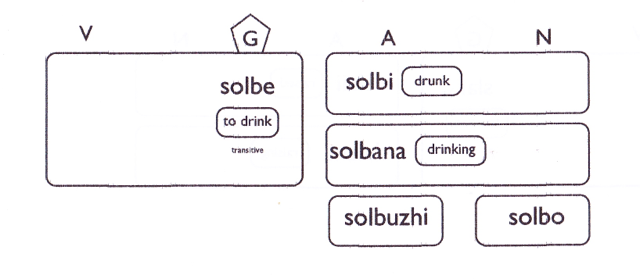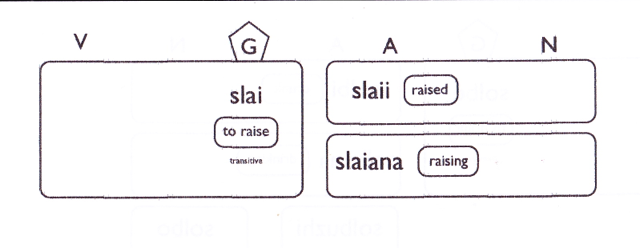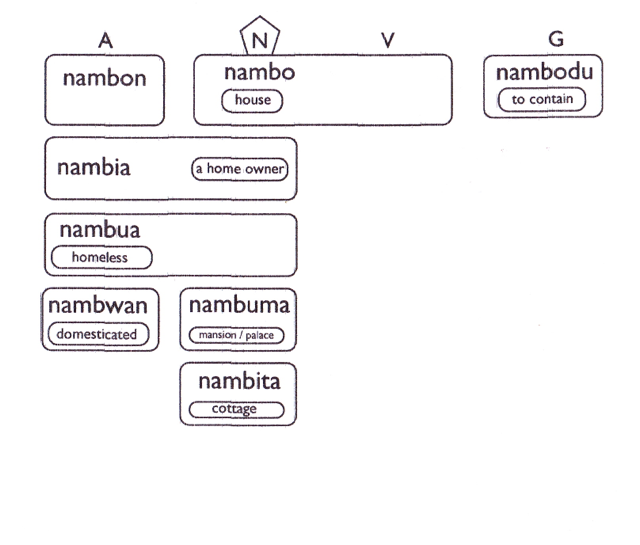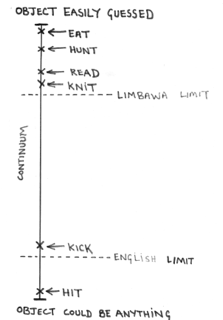Béu : Chapter 7
..... Verbs and how they pervade other parts of speech
slaii is pronounced as two syllables ... as you would say "sly "e" " ... glottal stop between the syllables ... quite easy to say.
slaianais pronounced as three syllables ... slai ... a ... na ... also easy to say.
..... Nouns and how they pervade other parts of speech
nambo
nambo meaning house is a fairly typical non-single-syllable noun and we can use it to demonstrate how béu generates other words from nouns.
nambodu
Not many nouns can be used as verbs. However when an action is associated to a certain noun, usually, with no change of form, it can be used as a verb. For example lotova means bicycle and you get lotovarwi meaning "I used to ride my bicycle". For the infinitive, du must be affixed to the basic form.
The meaning given to the verb nambo is arrived at through metaphor, it is not so straight forward as the bicycle example.
The use of all tools can be expressed in a similar manner to lotova.
nambon
Sometimes in English a bare noun can be used to qualify another noun (i.e. it can act as an adjective). For example in the phrase "history teacher", "history" has the roll usually performed by an adjective ... for example, "the sadistic teacher". This can never happen in béu, the noun must undergo some sort of change. The most common change for nambo is it to change into its genitive form nambon as in pintu nambon "the door of the house". Other changes that can occur are the affixation of -go or -ka. These are used with certain nouns more than others. They are not used that much with the noun nambo so I haven't included them in the chart above. You could use the forms nambogo or namboka if you wanted tho' (they would mean "house-like"). Maybe you would use one of these terms in a joke ... it would stike the listener as slightly odd however.
nambia
This is a very common derivation. Nearly all nouns can take this transformation.
nambia is an adjective meaning "having a home". And its use as a noun is quite common as well, in which case it would probably be translater as "a home owner"
nambua
Also a very common derivation. The opposite of nambia.
nambua means homeless or the homeless
Note that although ia and ua are exact opposites, the usage of the words produced from these affixes do not completely mirror each other. It all depends oner what the base word is.
For example, in this case, the form nambia is a bit rarer than nambia. Also nambua is used more often as an adjective than as a noun, while nambia is used more often as a noun than an adjective.
nambuma
Many of the worlds languages have a suffix that has this roll. Called an "augmentative" in the Western linguistic tradition. Does not really come into play in English but quite common in béu. As well as some basic forms that appear regularly in their augmentative version, any noun can receive this affix. But of course it will stick out if it is not commonly used.
nambita
The opposite of nambuma. Called an "diminutive" in the Western linguistic tradition. In béu it is often used to show that the speaker feels affection for the noun so transformed. There is no trace of the opposite for the augmentative : nobody would use the augmentative to show repulsion.
nambwan
The form changes that produce nambia, nambua, nambuma, nambita, *nambija are *nambeba affected by deleting the final vowel (or diphthong) and then adding the relevant affix. However with this change of form this is not always possible to delete the final vowel (example). In this example it is possible. In fact it is possible if the final consonant of the base word is j, b, g, d,c, s, k, t, l or m.
By the way nambwan means domestic or domesticated. Nearly always when you come across the word it is referring to animals.
Other derivations that are not possible with nambo
I have already mentioned nambogo and namboka which while possible, are not at all common. Also I will mention three other derivations that are quite common however can not occur with nambo.
1) -ija is affixed to the names of animals and give a word meaning the young of that animal. For example;-
huvu = sheep
huvija = lamb
mèu = cat
meuja = kitten
2) -eba is an affix that produces a word meaning "a set of something" where the base word is considered as a central/typical member of that set. For example;-
baiʔo = spoon
baiʔeba = cutlery
= chair
= furniture
nambeba could represent a set comprising (houses, huts, skyscrapers, apartment buildings, government buildings etc etc.), however this is already covered by bundo (derived from the verb bunda "to build").
3) -we ... Well the status of this one can be analysed in two ways. It could be said to be the same as the affixes mentioned above. An affix that generates an adverb* with the meaning "to act in the manner of xxxx". OK the nouns that are used with this affix tend to do something (to move) and as houses do not do much, I can not demonstrate using nambo.
Let us take deuta meaning "soldier". The word deutawe would be an adverb meaning "in the manner of a soldier". Note that if this is an affix. it has the form CV and hence does not overwrite the final vowel of the base word (unlike the other affixes).
An alternative way to look at this is a result of the "word-building" process (see section ???)
wé deutan means "way of a soldier" or "manner of a soldier".
Now if we follow the "word-building rules"
1) The genitive suffix n is dropped
2) The first syllable of the first word is dropped.
3) The remainder of the first word is affixed to the second word.
We get the form deutawe (wé being monosyllabic, we obviously can not delete its first syllable)
Probably the first analysis is correct, and we should keep fé deutan as a noun phrase, and deutawe as an adverb.
* I haven't mentioned adverbs before. They are a separate part of speech, but a part of speech that has a very marginal roll. For the most part, adverbs are the same as adjectives.
báu
..... -wan -uʒi and -go
wan is affixed to a few nouns and a few adjectives. Its has the sense of "tending towards","accustomed to" or "addicted to".
| ái | white | aiwan | faded |
| lozo | grey | lozwan | grizzled |
| pà | I | pawan | selfish |
| mama | mother | mamwan | motherbound |
| nambo | house | nambwan | domesticated |
| toili | book | toilwan | bookish |
bawa solbewan = men inclined to drink
The last one also makes adjectives from other adjectives. i.e.
hìa = red
hiawan = reddish
And it can make nouns from nouns
alha = flower
hawan = a bee
Note that wan tends to be affixed to nouns while uzhi gets affixed to verbs.
| to play | lento | playful | lentuʒi |
| to rest/relax | loŋge | lazy | loŋguʒi |
| to lie | selne | untruthful by disposition | selnuʒi |
| to work | kodai | diligent | koduʒi |
If the verb is monosyllabic, then -go is used instead of -uʒi.
Sometimes it is hard to tell if a word is basically a verb or a noun.
For example eskua is the gomia of a verb which means "to be angry". However it is also a noun meaning "anger".
However we can say that it is basically a verb as eskuʒi "bad tempered" !!!
How do we say "angry" ???
..... Number of categories
So now we can say, béu has ...
1 wepua
2 mazeba .......................... and 2 demonstratives
3 plova ......... participles ........ ʔinʔanandau or whatever words
4 teŋko ........ evidentials ........ relativizers or ʔasemo-marker
5 seŋgeba ..... modals ..... and 5 specifyana
6 ʔanandau ... question words
7 cenʔo ......... subject marked on the verb
9 ??? .............. personal pronouns
12 pilana (noun cases),
15 "specified"
16 gwoma (tense/aspect verbal affixes).
best to have 10 ??? conjunctions ???
The complement clause construction ???
wí = to see polo = Paul timpa = to hit jene = Jenny
wori polo timpa andai = He saw paul hitting something
wori pá timpana ó = He saw me hitting her
wori jene bwò timpa = He saw Jenny being hit
wori polo timpa jene = He saw Paul hitting Jenny
wori pà timpa jene = He saw me hitting Jenny.
In the above constructions the word order must be as shown above.
..... The transitivity of verbs in béu
All languages have a Verb class, generally with at least several hundred members.
Leaving aside copula clauses, there are two recurrent clause types, transitive and intransitive. Verbs can be classified according to the clause type they may occur in: (a) Intransitive verbs, which may only occur in the predicate of an intransitive clause; for example, "snore" in English. (b) Transitive verbs, which may only occur in the predicate of a transitive clause; for example, "hit" in English. In some languages, all verbs are either strictly intransitive or strictly transitive. But in others there are ambitransitive (or labile) verbs, which may be used in an intransitive or in a transitive clause. These are of two varieties: (c) Ambitransitives of type S = A. An English example is "knit", as in "SheS knits" and "SheA knits socksO". (d) Ambitransitives of type S = O. An English example is "melt", as in "The butterS melted" and "SheA melted the butterO".
English verbs can be divided into the four types mentioned above. béu verbs however can only be divided into two types, a) Intransitive, and b) Transitive. In this section it will be shown how the four English types of verb map into the two béu types. (Of course there is nothing special or unique about English ... other than the fact that a reader of this grammatical sketch will already be familiar with English)
Intransitive
..
An intransitive verb in English => an intransitive verb in béu
..
An example of an intransitive verb in English is "laugh". This is also an intransitive verb in béu. In a clause containing an intransitive verb, the only argument that you have is the S argument.
By the way ... some concepts that are adjectives in English are primarily intransitive verbs in béu, for example ;- to be angry, to be sick, to be healthy etc. etc.
Ambitransitive of type S=O
..
| x) An intransitive in béu | |
| An "ambitransitive of type S=O" => | y) A pair of verbs, one being intransitive and one being transitive |
| z) A transitive in béu |
..
x) "Ambitransitive verbs of type S=O" which have greater frequency in intransitive clauses, are intransitive verbs in béu.
For example ;- flompe = to trip, (ò)S flomporta = She has tripped
y) "Ambitransitive of type S=O" verbs which are frequent in both transitive and intransitive clauses, are represented as a pair of verbs in béu, one of which is intransitive and one transitive. There are a few hundred béu verbs that come in pairs like this. One should not be thought of as derived from the other; each form should be considered equally fundamental. All the pairs have the same form, except the transitive one has an extra "l" before its final consonant.
For example hakori kusoniS = his chair broke : (pás)A halkari kusoniO = I broke his chair :
z) "Ambitransitive of type S=O" verbs which have greater frequency in transitive clauses, are transitive vebs in béu.
For example ;- nava = to open, (pás)A navaru pintoO = I am going to open the door
Ambitransitive verbs of type S=A and Transitive verbs
. .
| An "ambitransitive of type S=A" | |
| or | => A transitive in béu |
| A transitive verb in English |
. .
I am taking transitive and ambitransitive of type (S=A) together as I consider them to be basically the same thing but tending to opposite ends of a continuum.
Consider the illustration below.
At the top (with the "objects easily guessed") are verbs that are normally designated "ambitransitive of type S=A".
At the bottom (with the "objects could be anything") are verbs that are normally designated "transitive".
.
.
Considering the top first. One can have "IA eat applesO" or we can have "IS eat"
Then considering the bottom. One can have "IA hit JaneO" but you can not have "*IS hit"
Moving up from the bottom. One can imagine a situation, for example when showing a horse to somebody for the first time when you would say "SheS kicks". While this is possible to say this, it is hardly common.
As we go from the top to the bottom of the continuum;-
a) The semantic area to which the object (or potential object if you will) gets bigger and bigger.
b) At the bottom end the object becomes is more unpedictable and hence more pertinent.
c) As a consequence of a) and b), the object is more likely to be human as you go down the continuum.
béu considers it good style to drop as many arguments as possible. In béu all the verbs along this continuum are considered transitive. Quite often one or both arguments are dropped, but of course are known through context. If the O argument is dropped it could be known because it was the previously declared topic (however more often the A argument is the topic tho', and hence dropped, represented by swe tho' as its case marking can not be dropped), it could be because the verb is from the top end of the continuum and the action is the important thing and the O argument or arguments just not important, or the dropped argument could be interpreted as "something" or "somebody", or it could be a definite thing that can be identified by the discouse that the clause is buried in.
Index
- Introduction to Béu
- Béu : Chapter 1 : The Sounds
- Béu : Chapter 2 : The Noun
- Béu : Chapter 3 : The Verb
- Béu : Chapter 4 : Adjective
- Béu : Chapter 5 : Questions
- Béu : Chapter 6 : Derivations
- Béu : Chapter 7 : Way of Life 1
- Béu : Chapter 8 : Way of life 2
- Béu : Chapter 9 : Word Building
- Béu : Chapter 10 : Gerund Phrase
- Béu : Discarded Stuff
- A statistical explanation for the counter-factual/past-tense conflation in conditional sentences




